
Bulletin 8 (IV:2), 1966
Home
Français
Introduction
History
Annual Index
Author &
Subject
Credits
Contact
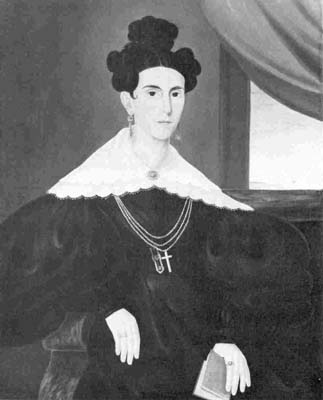
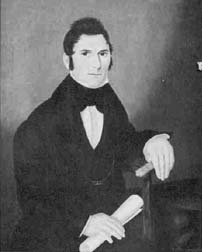
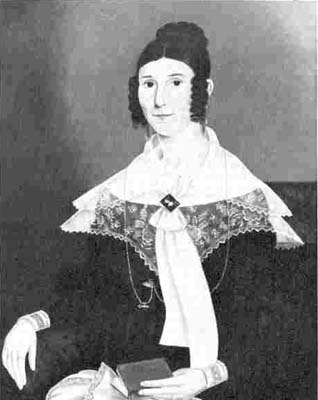
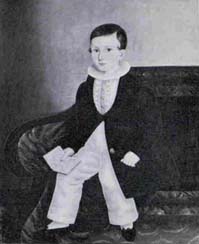
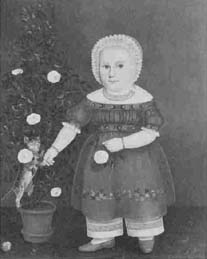
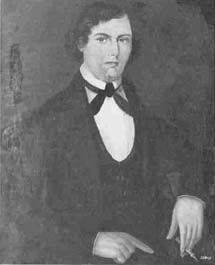
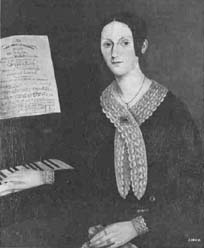
'Drawn by I. Bradley
From Great Britton'
by Mary Childs Black, Director
Museum of Early American Folk Art, New York
and Stuart P. Feld, Associate
Curator
of American Paintings and Sculpture
The Metropolitan Museum of Art, New York
Pages 1 | 2 |
3 | 4
Between 1832 and 1836, John Bradley had consistently
signed his portraits with the archaic 'I. Bradley'. In 1836 for the first
time he signed himself ' J. Bradley'. This appears on the portrait
of a serenely beautiful middle-aged woman in the collection of the National
Gallery of Canada, at Ottawa (Fig. 13). She is seated before a red-curtained
window on a richly veneered 'pillar and scroll' sofa similar to those advertised
by John Joseph Meeks of New York in 1833 (see Antiques, May 1962,
p. 504). In addition to earrings, a pin, a belt buckle, and four rings,
she wears a gold cross on a chain, an unusual detail in an American painting
of this period.
Although none of Bradley's paintings bear dates
later than 1836, the seven remaining pictures can be dated within a few
years on the basis of Bradley's changing ad dresses, which he consistently
inscribed on his portraits from 1837 on. Five portraits have come to light
with the signature' J. Bradley' and the address 128 Spring Street, where
he worked from 1837 until 1844. Two of these paintings, now separated, appear
to have been conceived as a pair. In addition to being inscribed identically,
the two portraits work exceptionally well as pendants, and the subjects
wear matching fobs on their watch chains. There are other interesting parallels
in the histories of the two pictures. The man has been identified as Mr
Britton (Fig. 14), a surveyor who laid out Bergen County in northeastern
New Jersey. (The man holds a folding rule and a rolled plan that would
indicate the profession of an architect or surveyor.) Although the name
is known there, no Britton to suit this description has been located in
Bergen County. The woman has been identified as Mrs Stephens (Fig. 15), which would seem to make the connection an improbable one. But a
portrait signed by J. Bradley was once owned by a woman with the last name
of Stephens in Closter, a town in Bergen County. Miss Stephens no longer
owns the signed portrait, and it seems likely that the Oberlin portrait was once hers.
As frequently happened, the owner's name became associated with that
of the sitter. Like the subject of the Ottawa portrait, the Oberlin
lady wears an elaborately embroidered bertha and a quantity of jewellery.
She sits on a similar sofa.
The sofa is repeated again
in another of the portraits with the 128 Spring Street address (Fig.16).
Boy on Empire Sofa sits rather stiffly in Bradley's most exuberant
version of the popular pillar and scroll sofa, holding a book titled The
History of Robin Hood, which may have been a short title for The
noble birth and gallant achievements of the remarkable outlaw Robin Hood,
from a manuscript in the British Museum, which was published in London
in 1827.
The two remaining portraits that date to 1837-44 are
nearly identical. They are full-length portraits of children standing
on brightly coloured carpets (Figs.17 & 18). In each case they share
the picture with a large potted rosebush and a cat. Although one of the
children has not been identified, the other was Emma Homan, who later became
Emma Homan Thayer and, appropriately enough, made water-colour sketches
of flowers that were used in books on horticulture. According
to family tradition, and in spite of Bradley's street address on the front
of the canvas, the portrait of Emma Homan was supposedly painted at Wading
Brook or Wading River, a small village near Riverhead, in Suffolk
County, Long Island.
The latest of Bradley's works are the portraits
of James Patterson Crawford and his wife Margaretta Bowne Crawford of Freehold,
New Jersey (Figs.19 & 20). Both are signed J. Bradley and are inscribed
with Bradley's last New York address,134 Spring Street, where he
is listed in the New York City directories from 1844 to 1847. By this time,
the camera was in common use, and the portraits show the influence of the new
device; colours that were once clear, warm and bright are darkened and
subdued. Bradley has seated Mrs Crawford next to the keyboard of a pianoforte,
on which is set a clearly inscribed sheet of music: 'The Angers Whisper / Sung
by Mr Wood, / A popular ballad from the Songs of the Superstitions of /
Ireland / Written
and Composed by / Samuel Lover / N. York [?] Published by E. Riley and Co 29
Chatham St: (According to the New York City directories, Edward C. Riley
was in business as a 'prof. music' at 29 Chatham Street from 1833 through
1843.) The words and music that follow are nearly as legible as the title.
The only other work that has been recorded that may be by John Bradley
is a pastel drawing of a vase of flowers on a marble slab.
It is signed, 'Drawn by J. Bradley - N.Y. 1846'. Its present location is
unknown, so that it is impossible to determine whether it is by the same
hand, but the form of the signature and the relationship of the subject
to the still-life elements in Little Girl in Lavender and Emma
Homan suggest that the attribution is not an improbable one.
All the known paintings by Bradley date between 1832 and
1847; for the last 11 years of this period he was a resident of New York City and was the
only person of that surname to be listed in the New York City directories as a painter,
always as a portrait painter and sometimes as a miniature painter as well.
The year following his disappearance from the Directory a number of painters
named Bradley are listed - but in all likelihood these men were house or
fancy painters and not artists.
John Bradley showed a marked
propensity to sign his portraits, frequently twice, and at this time no
unsigned pictures can be convincingly attributed to him. At first he signed
'I. Bradley', later he signed ' J. Bradley', but never 'I. J. H. Bradley',
the artist to whom The Cellist has been erroneously published
and exhibited for many years.
John Bradley left very few clues to his identity,
his origins and his interests. Most of his known subjects lived in New
York City, on Staten Island, and in New Jersey. He set down
two pieces of music - one a popular Irish ballad - so accurately that they might still be played. He
repeated his British origin five times and recorded the name of one of
his subjects, Mary Totten, as 'Mairy'. Between 1820 and 1832, the date of
Bradley's earliest known portrait, only two men listed as John or J. or
I. Bradley arrived as immigrants in New York. One of them, John Bradley,
a manufacturer from Liverpool, aged 26, arrived with his wife Sarah on
6 September 1827. But the more likely candidate to be the portrait painter
is the John Bradley who arrived a year earlier on 7 August 1826, aboard
the Carolina Ann. We know that he came from Ireland, but his age
and occupation are not given.
Next Page | Notes
and check-list of works
1 | 2 |
3 | 4
Annual Index | Author & Subject | Credits | Contact
This digital collection
was produced under contract to Canada's Digital Collections program,
Industry Canada.
"Digital
Collections Program, Copyright
© National Gallery of
Canada 2001"